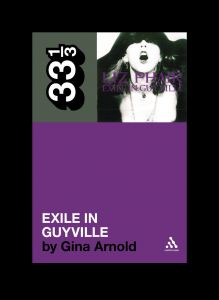by Keidra Chaney

But to be fair, music has always been difficult to write about – the whole “dancing about architecture” thing – And there’s only a handful of spaces, online and off, that allow writers the time, mental space – and the word count – to truly explore the ideas and concepts that make for great music writing. Often that’s rarely about the music itself, but about the people who create it, the fans that love it and its overall historical and cultural impact. It’s one of the elements that makes the 33 1/3 book series so such a stellar one. Gina Arnold’s contribution to the series, a reflection on the Liz Phair’s critically adored/maligned debut album is an example of the series at its best.
And yes, what you may have heard about the book is true; it’s not about the making of the album at all. Instead it’s about a number of things that are more compelling than hearing from studio engineers about the production process: it’s about the culture and mindset of the early 90’s indie rock scene in Chicago and beyond, the hyper-masculine, hyper-obsessive club dubbed “Guyville” by Phair and others at the time. It’s also about the changes in technology and culture that have changed what it means to be a part of the indie rock scene as a performer or a fan in the past 20 years. It also challenges – or at least explores – Phair’s assertion that “Guyville” was a track-by-track response to the Rolling Stone’s “Exile on Main Street” while also briefly touching on Arnold’s own former Rolling Stones fandom and it’s bitter end.
As you can see, the book covers a lot – a hell of a lot – in 116 pages. And expectedly, it’s a little messy. Not incoherent, mind you. Arnold’s writing is thoughtful, complicated, conflicted – as she deconstructs and pieces together her relationship to indie rock, and Phair’s relationship to the scene. She approaches the work as a fan, a participant and observer of the scene, and a critic, and doesn’t attempt to unravel these identities.
I think the fact that she doesn’t attempt to write with some false notion of “objectivity” that gives the book its voice and perspective. Her exploration of gender and indie rock fandom will sound very familiar to anyone following the misogyny in gaming/geek culture debates. Arnold writes:
There is a curious conundrum that haunts not just rock, but music itself. Somehow female fandom is both valuable (in that it generates cash) and at the same time laughable, while female connoisseurship, female artistry, and female ownership is … a lesser thing.
In fact, so much of what was going on in the indie rock scene at the time reminds of what is currently playing out online with women in gaming/geek culture, it’s rather eerie. Lest anyone thinks that somehow the indie rock world, even with its boys club mentality, have historically “played nice” when it comes to gender, there’s the jaw-dropping quote from Phair herself that you could pretty much do a search and replace and say it’s about geek culture today:
“Guyville” was a specific scene in Chicago – predominately male, indie-rock, and they had their little establishment of who was cool, who was in it, who played in what band. Each one wore their record collection, so to speak, as a badge of honor. Like “this is my identity, this is what I’m into, and I know a lot about it…
Guyville is not dead, as Arnold asserts, it’s just moved to a different medium.
While Arnold’s criticism and writing is solid there are a couple of “Whoa Nellie” moments, for example, when she attempts to make a connection between Phair’s “Guyville” and Franz Fanon (it’s a stretch). And there’s a lot more that could have been said about the economics of indie rock and gender, namely her assertion (i think I am paraphrasing idea this correctly) that women are now more accepted and prominent in the indie rock scene because there’s no real economic power or exclusivity in it anymore. It’s been “pink collar-ed,” I actually think there’s some truth, and would love to read more exploring this theory.
But the fascinating thing about this book is that it’s not attempting to make some kind of declarative statement about rock criticism and gender, or indie rock in the age of the Internet. She doesn’t spend time trying to convince you that the album is a musical masterpiece. Good god, you can go to pretty much any rock-bro blog or message board and find a bunch of guys having that conversation at any time. The book intends to do something more. It’s meandering, touching on a lot of different ideas, but not lacking in focus. Music writing, interesting music writing, that is, touches on the personal, the political, the cultural, the historical and gives you something to chew on to make you want to listen to the music itself, even if you’re not a fan.
I’m actually not a fan of Liz Phair at all; when “Guyville” came out I was gorging on a diet of metal, new jack swing and mainstream hip-hop, and gave all things indie rock the gas face. I likely never will be, but reading Arnold’s analysis makes me want to revisit “Guyville” in an attempt to see things through her eyes.
Summary: A thoughtful, complicated look at 90’s indie rock culture with Phair’s album as a jumping off point. Highly recommended.

